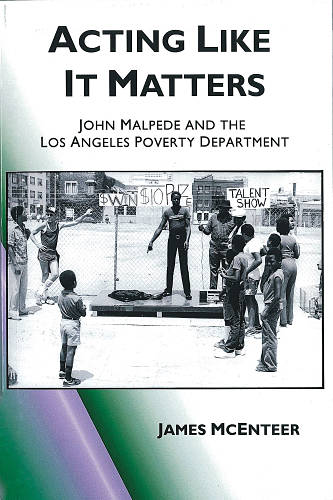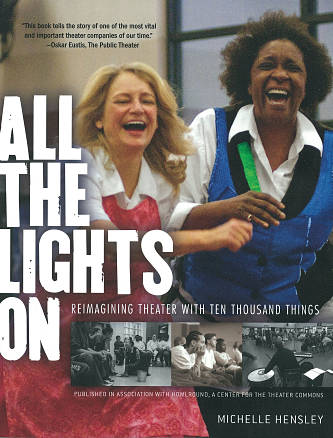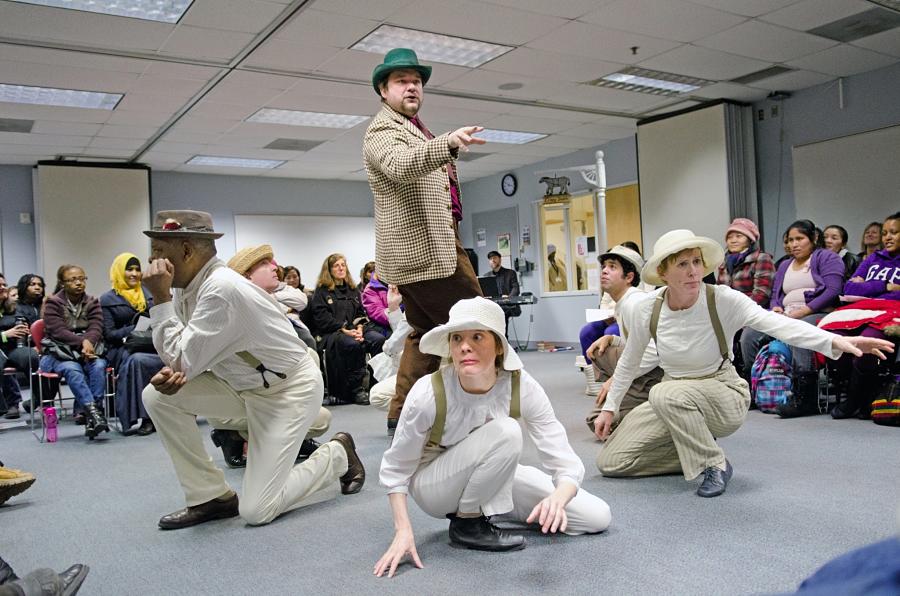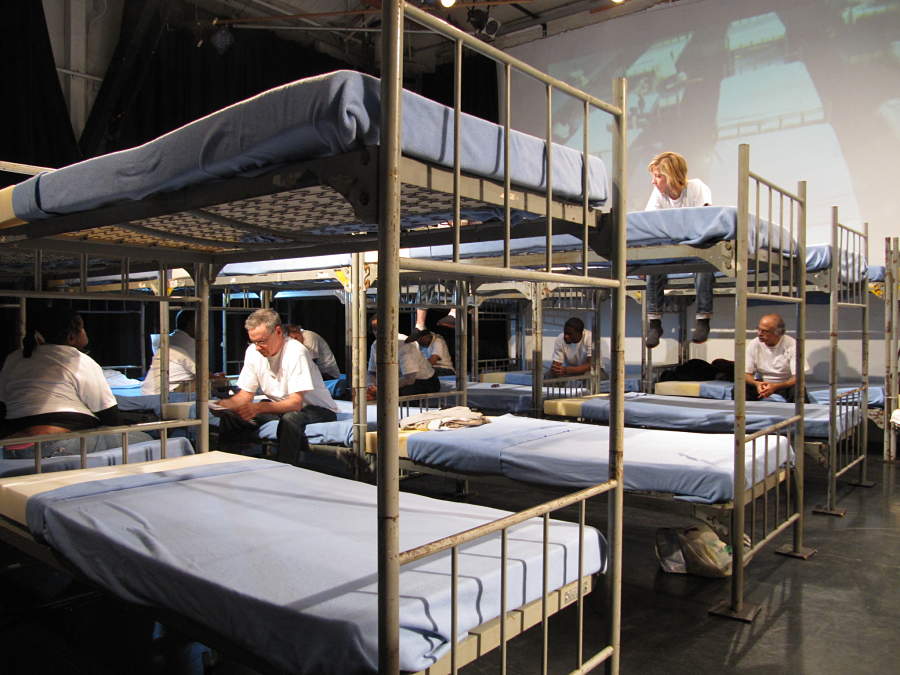Recently one of the senior editors at the once-alternative L.A. Weekly newspaper, for which I write a biweekly theatre column, proposed a story on a local juvenile court judge who happens to be a huge theatre fan. The judge demurred, preferring to remain out of the limelight. “He felt badly,” the editor told me, “and had a different story he figured you might want to write. It’s about theatre in prisons or something. But I told him that’s too feel-good for us—we want stories with more of an edge.”
That’s when it struck home, and hard, the extent to which the Weekly, and the world it covers, has changed. The United States currently holds 5 percent of the world’s population—and 25 percent of the world’s prison population. In 1996, the L.A. Weekly ran a two-page spread on director Joseph Haj’s production of Henry V with inmates at California’s Lancaster State Prison; today, that same newspaper wouldn’t consider running such a story.

James McEnteer’s Acting Like It Matters, a history of John Malpede’s work with Los Angeles Poverty Department—a theatre dedicated to employing L.A.’s homeless in its stage work—has citation after citation from the decade between 1985 and 1995 of breathless coverage of the troupe by various writers from L.A. Weekly. It was an ideological given then that among theatre’s highest purposes and sources of relevance was to reach into underserved, even indigent, populations, and bring them from invisibility into the light. But as the number of U.S. billionaires doubled in the 1980s, resulting by 2013, McEnteer recounts, in “the highest income gap of any of the advanced countries, with the top 1 percent capturing over 90 percent of income growth,” the American promise of opportunity and fairness has effectively calcified and crumbled—and this reversal of fortunes, largely born of shifting distributions of wealth, has disrupted the middle class and its engagement with high-priced institutional theatre.
Acting Like It Matters is one of two recently published books that are like close cousins who share a perspective, even an ideology, but have entirely different personalities. The pleasures of both narratives derive from their interweaving themes of estrangement, and the light they shine on our theatre’s alliance with a world that leaves swelling populations in the dark. As Michelle Hensley points out in All the Lights On, her firsthand account of the theatre in Minneapolis she founded, Ten Thousand Things, that estrangement begins at the door, with theatres’ high ticket prices.

224 pp., $18.63 paper.
Indeed, both books see most of our theatres, and the world they reflect, as bastions of privilege and exclusion. And both authors focus on the noncommercial theatres founded by their subjects—theatres that have for decades taken direct aim at those bastions. Both Malpede and Hensley are children of the 1960s and, unlike many others, have remained true to the decade’s Pete Seegerish communitarian ideals. Part of the nobility of their effort is the somewhat quixotic priority they place on values other than commerce and popularity—an idealism that might be easy to disparage, if each of these new books didn’t argue so persuasively for the urgency of what they’re doing.
This isn’t an importance derived from boasting, or even from some spurious “eat your spinach” rectitude, but more from the stark empirical realities of what they’re both battling (a survey by the Los Angeles Homeless Services Authority found an 85-percent increase in the number of people living in tents and cars over the past two years) and their respective dedication to their battles. Malpede and Hensley shall not be moved.
Hensley starts with Bertolt Brecht, eagerly and repeatedly pointing out the virtues of Brechtian storytelling in the classrooms and daycare centers and correctional facilities where her company does its work, without any traditional accoutrements of sophisticated lighting or set designs. Primal simplicity is key.
Hensley’s sense of purpose was formed after graduate school in Southern California in the early 1980s. Even then, she was disenchanted with institutional theatre in general, and in Los Angeles in particular. She fled to San Francisco in “a luxurious bubble of exploring and not knowing,” working in coffee shops and a nursery school, as a puppeteer at an elementary school in Haight-Ashbury, meanwhile reading Peter Brook, Grotowski, Artaud, and Joseph Chaikin.
Returning to L.A., she assembled some actors to present Brecht’s The Good Woman of Szechwan on an ad hoc stage, on a beach in Santa Monica near a homeless center. Unlike in Malpede’s LAPD, the homeless were not her actors. Rather, they were her audience, about 30 strong—some of whom moved from cynicism and wariness (what on earth did a portable theatre troupe think it was doing on their turf?) to engagement and interactive participation. They ended up cheering on the lead character, Shen-Te, challenged by three gods to do good in the world.
“How can I be good when everything is so expensive?” Shen-Te asks—a question, Hensley reports, that drew murmurs of approval. The audience also approved of Shen-Te’s alter-ego, the ruthless businessman Mr. Shui Ta (played by the same performer, Christi Mays). What unfolded on that beachhead of destitution was the question of whether it is more expedient to go through life being virtuous or duplicitous. The production offered no answer, just as Brecht did not; it served up a paradox that the audience, or what remained of it after the performance, seemed to appreciate. Some audience members left during the show, Hensley explains, because, as she later realized, they had appointments with case workers—though maybe some left because they were bored. How does one measure success?
All The Lights On is part diary and part exegesis on principles that have evolved through Hensley’s decades of work in the theatre: Respect the audience, for example. From her Good Woman of Santa Monica, she learned the folly of what could easily have been condescending or preaching down to people who, though impoverished, may well be smart and urbane. There’s no do-gooding about her work. Her book instead offers principles on emotional pain, on metaphor, on rehearsals, on script work, on fable and parable—all of which accrue into an aesthetic.

Hensley’s aesthetic is not without its ideological overtones. She resists embracing A Midsummer Night’s Dream, for example, because of the way Shakespeare treats women in that play, and she avoids Romeo and Juliet, along with a multitude of classics in which the central conflict is the plight of daughters subjected to fathers with a pivotal say in selecting their husbands. That’s all three steps removed from contemporary realities, she says, and another impediment to engaging new generations of audiences in the already crumbling artifice of our institutional stages. Hensley prefers, for instance, Roman comedies in which wily servants trick their masters. Her view is a feminist echo of Britain’s Angry Young Men movement of the 1950s, which disparaged plays about the rich as dated artifacts, antiques for the museum.
The key difference between Hensley’s book and McEnteer’s is the difference between a book written by an artist and one written about artists. McEnteer’s book comes marbled with scholarship, with quotes from journalists, and with insights from the book’s subject, Malpede.
But it, too, is beautifully and persuasively written, in a tone that holds high regard for Malpede, himself a product of New York’s 1970s performance scene, without sanctifying him.
The essence of Malpede’s challenging work comes into focus in the story of his work with homeless actor Jim Beame. Beame “had been kicked out of virtually all the shelters on Skid Row for his loud, abusive behavior,” McEnteer writes. “He interrupted long recitations of baseball or basketball statistics only to make lewd comments to any women who happened to be present. Conversation with him was impossible. By the time he joined LAPD, he had been on the streets for six years, living in a vacant lot near Chinatown, eating out of the trash.”
The book quotes Malpede: “His behavior was intolerable. The only reason he continued in the theatre group is because we have a policy of tolerating the intolerable.”
Malpede tried to help Beame reinstate his disability insurance, as then-president Reagan had established a new policy requiring recipients of national disability to pay to recertify to keep their benefits. Nine months later, Malpede learned that Beame’s pro-bono lawyer had won his case. “All he had to do was sign a paper saying he was schizophrenic and he would receive $761 a month in benefits, plus $30,000 in back pay for the months since his wrongful termination.” But Beame would not sign, saying, “That’s signing my death warrant . . . I’ll be blackballed from law school, from teaching, from real estate.” McEnteer concludes grimly: “Malpede cajoled, threatened, and begged, but Jim refused and eventually drifted away.”
Among the LAPD’s myriad pieces, Acting Like It Matters puts special emphasis on Agents and Assets, a show based on transcripts from the Iran-Contra hearings about allegations that the CIA paid auxiliary agents for anti-Nicaragua “contras” for cocaine that was then disseminated in South Central Los Angeles—all during Reagan’s alleged “war on drugs.” LAPD has taken the piece to Europe and Latin America (see AT, May/June ’10, “Counting the Cost”), emblematizing the theatre’s tightest bonds to the world it depicts.
It’s probably apt that a theatre company dedicated to the marginal should itself exist on the fringes of L.A.’s theatre scene. McEnteer offers a powerful record of an enduring troupe currently under siege by the gentrification of downtown Los Angeles, and the threat that gentrification poses to the already shattered health and safety of the largest homeless population in the nation. Los Angeles is a city with a famously short memory of itself, and Acting Like It Matters is in part a powerful corrective to that amnesia. It is also a fitting tribute to an organization that, for all its struggles with a tough population, has actually saved lives, and to the brainy, bewildered, priest-like man who runs it.
Our lives are ephemeral, after all; our theatre is more so. The classical Greek age of theatre lasted no more than about 80 years. The Elizabethan playhouses thrived for maybe 50 years, then died out. Yet the literary residue of those fleeting eras has helped, for centuries, to shape, define, and redefine who we are via who we were. Our identities, along with our values, emerge from the stories we choose to tell, and the stories we choose to ignore, both onstage and in print. Hensley and McEnteer deserve our gratitude for preserving histories and values that might otherwise roll into the shadows of our market-based culture.


